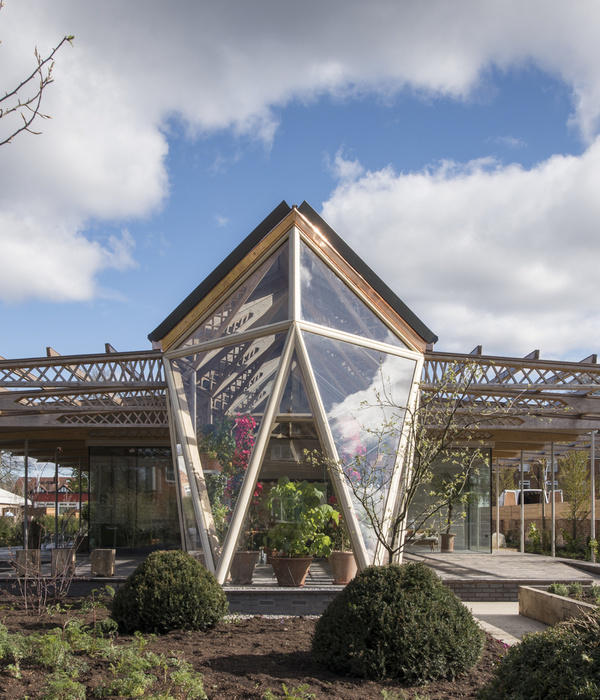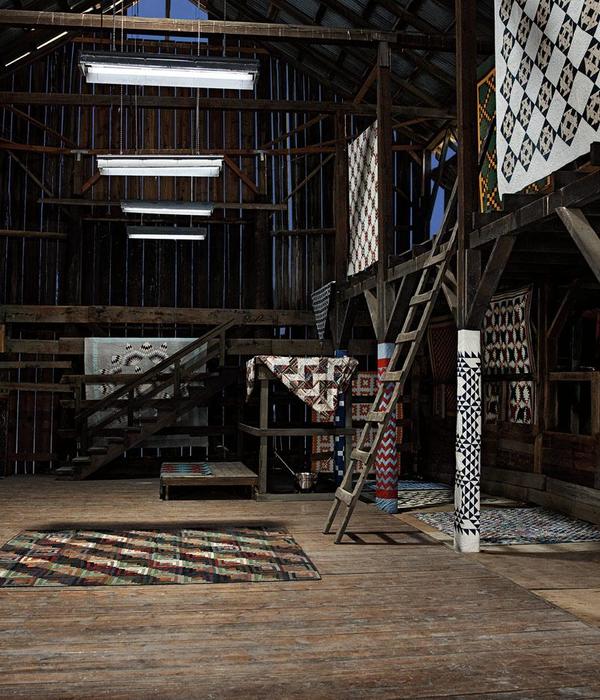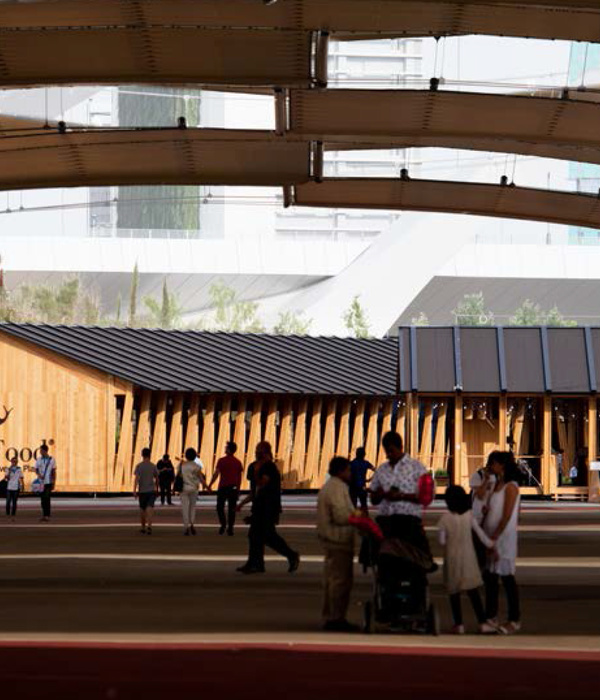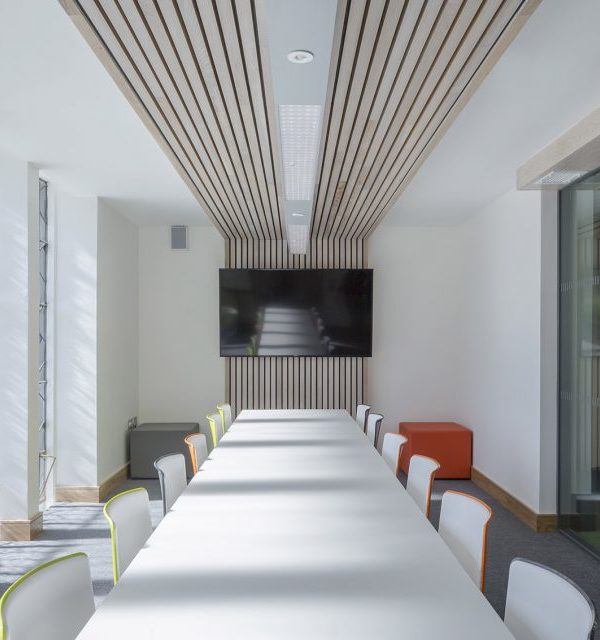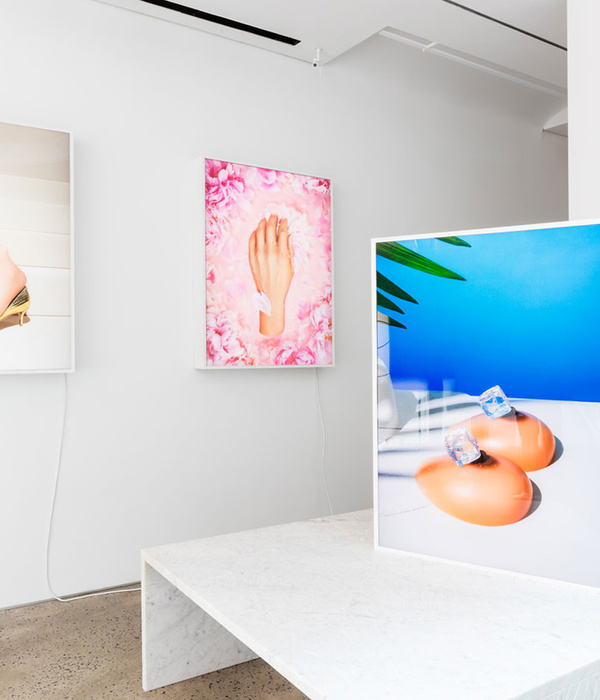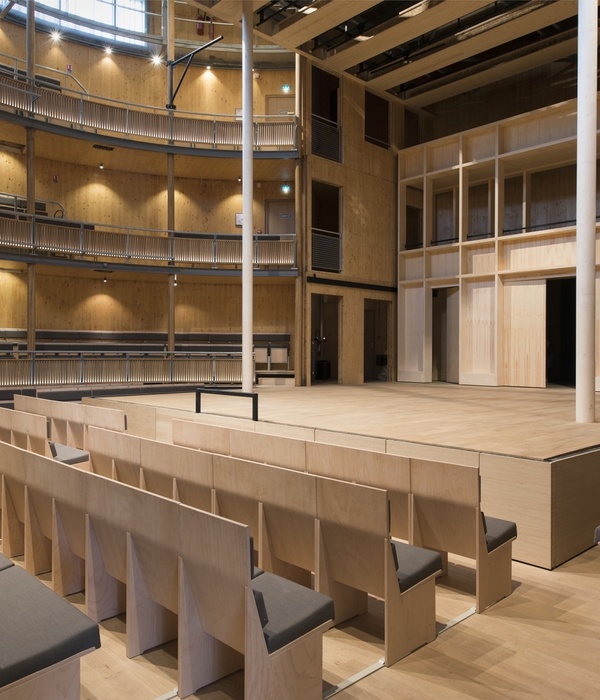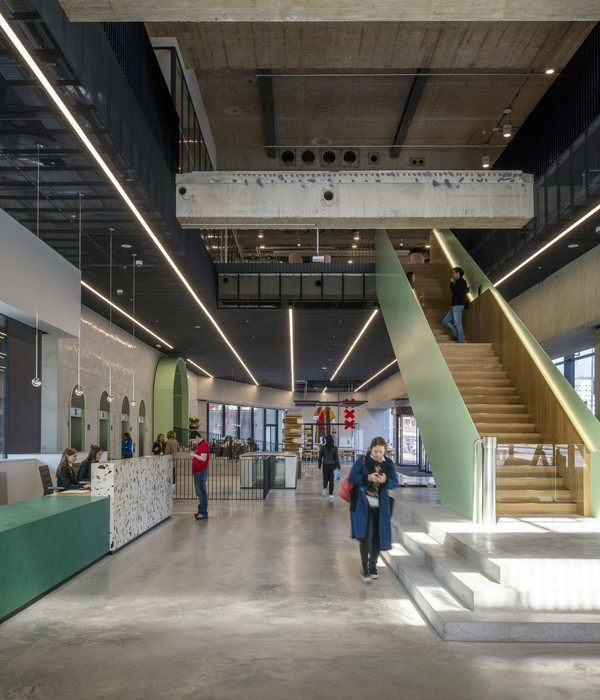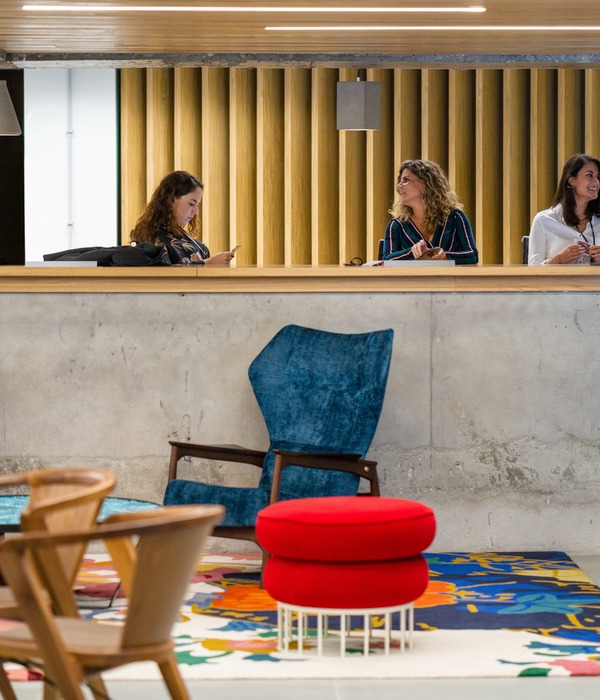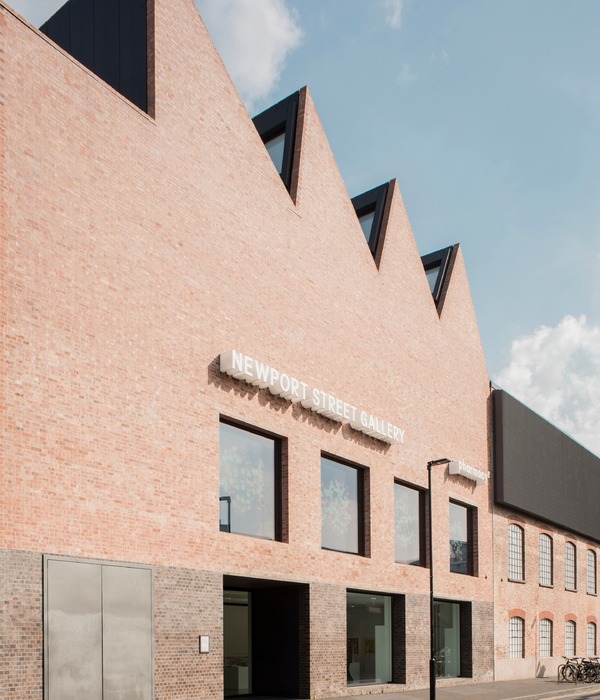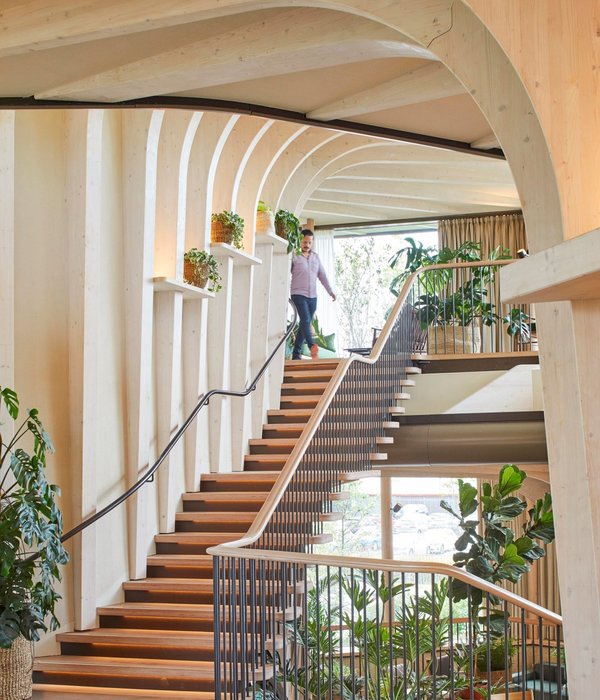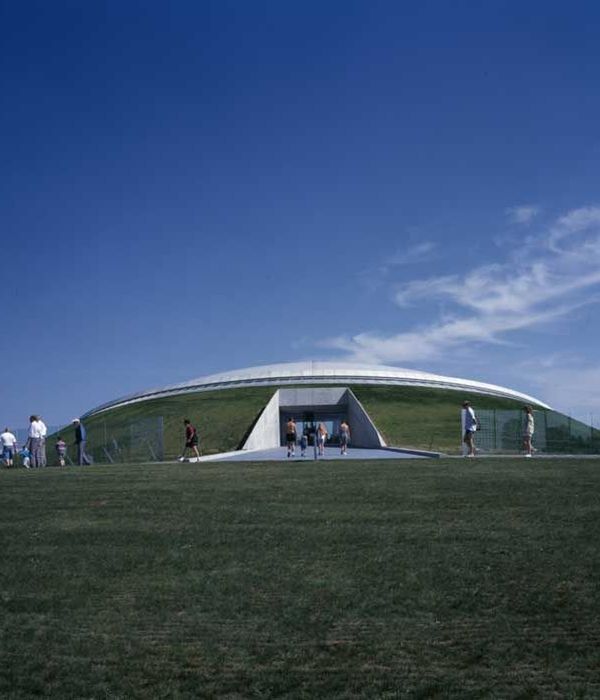在Sheikh Tamim bin Hamad bin Khalifa Al Thani殿下的支持下,卡塔尔国家博物馆 (National Museum of Qatar) 于2019年3月28日正式向公众亮相。名师让·努维尔(Jean Nouvel )凭著这座建筑杰作,为全球访客带来无与伦比的沉浸式体验。
Under the patronage of His Highness Sheikh Tamim bin Hamad bin Khalifa Al Thani, Qatar Museums will open t he National Museum of Qatar (NMoQ) to the public on 28 March 2019, welcoming the world to an unparalleled immersive experience housed in a new architectural masterpiece by Jean Nouvel.
▼博物馆鸟瞰图,aerial view
卡塔尔国家博物馆内蜿蜒的展馆长廊长1.5公里,透过一系列独特且包罗万象的环境,带领访客步入一场旅途,从建筑空间、音乐、诗歌、口述史学、气味、考古文物、画作、纪念艺术电影等,生动演绎着属于卡塔尔的故事。馆内的11个陈列展馆,带领访客穿越卡塔尔从数百万年前的一个半岛,演变成今天现代多元的国际城市的一段漫长历史。卡塔尔国家博物馆不但展现了这个国家丰富的文化历史和卡塔尔人的美好理想,同时促进探索、创意和社区交流,为当地提供多样的教育机会,更将卡塔尔国家的文化愿景推向国际舞台。
The Museum’s winding, 1.5-kilometer gallery path is a journey through a series of unique, encompassing environments, each of which tells its part of the story of Qatar through a special combination of architectural space, music, poetry, oral histories, evocative aromas, archaeological and heritage objects, commissioned artworks, monumentally-scaled art films, and more. Together, the eleven permanent galleries take visitors from the formation of the Qatar peninsula millions of years ago to the nation’s exciting and diverse present. Giving voice to the nation’s rich heritage and culture and expressing the aspirations of its people, NMoQ will serve as a hub for discovery, creativity, and community engagement, providing diverse educational opportunities for Qatar and advancing the nation’s cultural vision on the global stage.
▼广场视角,view from the plaza
▼博物馆外观,exterior view
壮观的卡塔尔国家博物馆占地52,000平方米,其核心组成部分是曾被现代卡塔尔的创始人之子Sheikh Abdullah bin Jassim Al Thani殿下 (1880-1957)修缮的宫殿,历史悠久。这里在改建为原有的国家博物馆前也曾是皇家住所和政府所在地,现在被誉为全新的卡塔尔国家博物馆中最耀目的亮点。
The spectacular 52,000-square-meter (560,000-square-foot) NMoQ embraces as its centerpiece the restored historic Palace of Sheikh Abdullah bin Jassim Al Thani (1880-1957), son of the founder of modern Qatar. A building that in former times was both the home of the Royal Family and the seat of government, and was subsequently the site of the original National Museum, the historic Palace is now the culminating exhibit in the sweeping succession of gallery experiences.
▼博物馆的核心组成部分是曾被现代卡塔尔的创始人之子Sheikh Abdullah bin Jassim Al Thani殿下修缮的宫殿,NMoQ embraces as its centerpiece the restored historic Palace of Sheikh Abdullah bin Jassim Al Thani, son of the founder of modern Qatar
卡塔尔国家博物馆主席Sheikha Al Mayassa bint Hamad bin Khalifa Al Thani阁下表示:“卡塔尔国家博物馆的落成,令我们整个国家感到骄傲,很高兴能够与来自世界各地的人们一起见证这个特别的时刻。开幕活动精彩纷呈,吸引了一众来自卡塔尔和全球的杰出艺术家、建筑师、思想家和文化领袖齐聚在此。文化连接彼此,全新博物馆的落成,我们相信它将创造了一个卓越的对话平台。
Her Excellency Sheikha Al Mayassa bint Hamad bin Khalifa Al Thani, Chairperson of Qatar Museums, said, “The opening of the National Museum of Qatar is a source of immense pride for our country, and an exceptional moment for engaging with people from around the world. The extraordinary schedule of inaugural activities draws together outstanding artists, architects, thinkers, and cultural leaders from Qatar and the international community, vividly demonstrating how the National Museum of Qatar will always be a dynamic resource in its programs as well as its exhibitions. Culture connects people, and with this new museum we believe we have created an exceptional platform for dialogue.”
▼馆内包含11个陈列展馆,带领访客穿越卡塔尔从数百万年前的一个半岛,together, the eleven permanent galleries take visitors from the formation of the Qatar peninsula millions of years ago to the nation’s exciting and diverse present
卡塔尔国家博物馆馆长Sheikha Amna bint Abdulaziz bin Jassim Al Thani表示:“经过12年的规划,我们非常激动能够迎接来自卡塔尔和全球的访客,莅临这个多视角的体验式的博物馆。从项目启动,卡塔尔国家博物馆的团队深谙我们力求创造一个有灵魂的博物馆。我们的展馆充满互动、 声音和色彩,激发访客的感知、情感和智力,呈现创意和原汁原味的内容,让访客的每次到访都有全新的发现。”
Sheikha Amna bint Abdulaziz bin Jassim Al Thani, Director of the National Museum of Qatar, said, “After more than a decade of planning, we are deeply gratified to welcome the people of Qatar and our international visitors to this exciting, multi-layered, experiential museum. From the start, Qatar Museums and the National Museum team knew that we wanted to create a living experience for our people—a museum with a heart. We have created galleries full of movement, sound, and color in order to engage our public fully, with their senses and emotions as well as their intellects, and have assembled creative and authentic content that is so rich that people will discover something new with each visit. It is now time for the discoveries to begin.”
▼外观细部,exterior detailed view
在设计过程中,让·努维尔(Jean Nouvel)从波斯地区“沙漠玫瑰”这一神奇的自然现象汲取灵感,“沙漠玫瑰” 是由沙漠表面下的盐水层中发现的结晶砂等的矿物质组成,因形似玫瑰而得名。让·努维尔这样形容“这是第一个由大自然创造的建筑结构”。“沙漠玫瑰”是建筑结构的模型,尺寸和弯曲度不同的圆盘交错,垂直结构起到支撑作用,横向错落叠加,如项链一般环绕着整座博物馆。Baraha中庭坐落在展馆区中心,是连接户外文化活动的聚集点。外观上,博物馆沙漠色的混泥土结构与沙漠环境相得益彰,建筑仿佛破土而出。内部环环相扣的圆盘结构,形成不规则曲面的墙面。
In designing the building that makes these experiences possible, Jean Nouvel drew inspiration from the desert rose, a flower-like formation that occurs naturally in the Gulf region when minerals crystallize in the crumbly soil just below the surface of a shallow salt basin. Described by Nouvel as “the first architectural structure that nature itself creates,” the desert rose became the model for the Museum’s complex structure of large interlocking disks of different diameters and curvatures—some vertical and constituting supports, others horizontal and resting on other disks—which surround the historic Palace like a necklace. A central court, the Baraha, sits within the ring of galleries and serves as a gathering space for outdoor cultural events. On the outside, the Museum’s sand-colored concrete harmonizes with the desert environment, so that the building appears to grow out of the ground and be one with it. Inside, the structure of interlocking disks continues, creating an extraordinary variety of irregularly shaped volumes.
▼设计从波斯地区“沙漠玫瑰”这一神奇的自然现象汲取灵感,尺寸和弯曲度不同的圆盘如项链一般环绕着整座博物馆, inspired from the desert rose, the Museum’s complex structure of large interlocking disks of different diameters and curvatures which surround the historic Palace like a necklace
▼“第一个由大自然创造的建筑结构”,“the first architectural structure that nature itself creates”
建筑师让·努维尔表示: “将‘沙漠玫瑰’作为建筑设计的基础,是一个非常超前的想法,甚至是乌托邦的想法。为建造这个外形如“沙漠玫瑰”充满巨型曲面圆盘、交错和悬臂结构的建筑,我们面对巨大的技术挑战。和卡塔尔一样,这座建筑采用了大量超前的技术。因此,它创造了一种融合建筑、空间和感官的独一无二的体验。” 同时,建筑采用大量可持续性环保的设计元素,提供自然遮阳的悬臂式圆盘便是其中之一,令卡塔尔国家博物馆成为首个获得LEED金级认证以及全球可持续性评估体系(Global Sustainability Assessment System)四星级评级的博物馆。
Jean Nouvel said, “To imagine a desert rose as a basis for design was a very advanced idea, even a utopian one. To construct a building with great curved disks, intersections, and cantilevered angles—the kind of shapes made by a desert rose—we had to meet enormous technical challenges. This building is at the cutting edge of technology, like Qatar itself. As a result, it is a total object: an experience that is at once architectural, spatial, and sensory, with spaces inside that exist nowhere else.” The cantilevered disks, which provide natural shade, are among the elements of the design that have enabled NMoQ to become the first museum to receive both LEED Gold certification and a four-star sustainability rating from the Global Sustainability Assessment System.
▼提供自然遮阳的悬臂式圆盘突显了设计的可持续性,the cantilevered disks, which provide natural shade, are among the elements of a sustainable design
2019年3月27日晚,Sheikh Tamim bin Hamad Al Thani殿下将出席卡塔尔国家博物馆开幕仪式,同时来自全球的国家元首、政要及博物馆高层也将莅临现场。
The National Museum of Qatar will be officially inaugurated by His Highness the Amir, Sheikh Tamim bin Hamad Al Thani, in an opening celebration attended by heads of state, dignitaries, and museum leaders from around the world on the evening of 27 March 2019.
▼拱廊视角,view from the arcade
包罗万象的丰富体验,讲述卡塔尔的故事
Telling the Story of Qatar Through Encompassing Experiences
卡塔尔国家博物馆共分为三个章节:“起源”、“生活在卡塔尔”以及“卡塔尔当代史”,11个展馆带领访客领略卡塔尔半岛的发展全貌,从尚无人居住的远古地质时期直至今天。观众可从中了解到半岛的形成及其自然栖息地、沙漠及海岸生活遗迹、当代卡塔尔的政体发展、石油发掘、以及卡塔尔与世界各国建立的广泛联系。
口述历史纪录片、档案照片、地图、文本、模型以及数字化学习中心等全方位的资料为参观者呈现了卡塔尔历史及遗产中最为人瞩目的宝藏。博物馆委托众多国际知名电影制片人制作了一系列艺术短片,通过生动的形式为观众呈现丰富主题。每个高清巨幅短片均为动态曲面的不规则墙面度身定制,令墙面成为移动的舞台。所有影片均有多哈电影学院使用尖端技术制作,并在卡塔尔境内完成拍摄。
NMoQ is organized in three chapters—“Beginnings,” “Life in Qatar,” and “The Modern History of Qatar”— presented in eleven galleries, which take visitors from the geological period long before the peninsula was inhabited through to the present day. Passing through the galleries, visitors are caught up in the experience of the formation of the Qatar peninsula and its natural habitat, the heritage of life in Al Barr (the desert) and on the coast, the political development of modern Qatar, the discovery of oil, and Qatar’s multifaceted relationships today with the larger world.
Oral history films, archival photographs, maps, texts, models, and digital learning stations establish the narrative, along with some of the most dazzling treasures of Qatar’s history and heritage. Surrounding the objects and bringing the experience to life is a sequence of short art films that NMoQ commissioned from a roster of distinguished international filmmakers. The films are projected at immense scale and with hypnotic clarity against the walls of the galleries, with each one uniquely suited to the dynamically curving, irregular shape. With their towering size, the films seem to make the walls dissolve into moving spectacles. All films were produced by the Doha Film Institute using cutting-edge technologies and were shot within the borders of Qatar.
▼展馆平面图,gallery plan
展馆介绍
The galleries
“卡塔尔的起源”展示了该地区远古七个不同纪元的植物和动物化石。由Christophe Cheysson创作指导下制作的影片《起源,2018》(The Beginnings, 2018)向观众展示了半岛形成初期的生命形态,并通过数字技术将早已灭绝的动植物及消失的景观鲜活地呈现在观众眼前。
“The Formation of Qatar” incorporates a display of fossils of plants and animals that represent seven time periods of Qatar in the distant past. A film made under the creative direction of Christophe Cheysson (The Beginnings, 2018) encircles the viewer with images of the formation of the peninsula and early life-forms, while digital displays bring to life long-extinct plants and animals and now-vanished landscapes.
▼“卡塔尔的起源”展馆,The Formation of the Qatar Peninsula gallery
“卡塔尔的自然环境”展示了各类土壤植物及动物的标本和模型,包括阿拉伯剑羚、沙丘猫、杀人蝎、以及鱼类中体型最大的长达9米的鲸鲨。在导演Christophe Cheysson和传奇电影制片人Jacques Perrin创作的万花筒一般的影片《陆地和海洋,2017》(Land and Sea, 2017)中,飞鸟布满了50米宽的天空,鱼群在深处游动,风暴震撼感官。
“Qatar’s Natural Environments” features models and exhibits about indigenous plants and animals from the Arabian oryx, the sand cat, and the deathstalker scorpion to the largest of all fish, the nine-meter-long whale shark. In a kaleidoscopic film experience by director Christophe Cheysson and legendary filmmaker Jacques Perrin (Land and Sea, 2017), birds fill a sky 50 meters wide, schools of fish swim through the deep, and a windstorm dazzles the senses.
▼生物多样性展览 – “卡塔尔的自然环境”馆,Biodiversity exhibits in Qatar’s Natural Environments gallery
▼海洋生物展示区,Marine Biota in Qatar’s Natural Environments gallery
“卡塔尔考古学”展示了大约一千件考古文物,从奢侈品到日常用品,追溯了半岛上从数年前最早的人类出现到19世纪繁荣城镇的生命轨迹。一部由Jananne Al-Ani拍摄的影片《考古学,2017》(Archaeology, 2017)将卡塔尔的考古遗址带入展馆,结合了广阔的高空鸟瞰视角与文物近景,展现了从史前时期至青铜时代及其后文明历程的发展。
“The Archaeology of Qatar” incorporates displays of some 1,000 archaeological artifacts, from luxury items to functional everyday objects, which trace life on the peninsula from the earliest human presence thousands of years ago to the thriving towns of the 1800s. A film by Jananne Al-Ani (Archaeology, 2017) brings Qatar’s archaeological sites into the gallery, combining aerial views with compelling close-up images of objects from pre-historic times into the Bronze Age and beyond.
▼“卡塔尔考古学”展馆,按时间顺序排布的展品,Core Chronology in The Archaeology of Qatar gallery
“卡塔尔人民”首先探讨了卡塔尔人的基本行动规律:季节性地在内陆沙漠及海岸间迁徙、不断寻找水源和牧场、以及买卖商品。展厅围绕着半岛的三维雕塑展开,阐述了几个世纪以来游牧民族赖以生存的生活方式。展厅中的物品包括精心制作的骆驼鞍座、皮革水袋、以及从一艘1000年前印尼海岸沉默的商船中打捞出的系列文物。卡塔尔人们的面貌和声音通过特约导演Jon Kane的口述历史纪录片,讲述他们在这片土地上的生活经历。
“沙漠生活”将生活在内陆沙漠中的挑战、快乐与满足感跃然呈现。展馆展示了一个完整的帐篷、手工编织、各类炊具,周围环绕着诗歌声,弥漫着咖啡的香气。由Abderrahmane Sissako创作的《沙漠生活,2017》(Life in Al Barr, 2017)以精致的银盐胶片风拍摄,将日常生活的循环往复展现在长长的展厅墙面上。
“The People of Qatar” begins with an exploration of movement as a fundamental element in the identity of the Qatari people: seasonal movement between al barr (the inland desert) and the coast; movement to find water and pastures, and movement to buy and sell goods. The gallery is organized around a three-dimensional sculpture of the peninsula and tells the story of how survival depended for centuries on a nomadic way of life. Objects in the gallery include elaborate camel saddles, leather water bags, and an array of artifacts rescued from the wreck of the Cirebon, a trading vessel that sank 1,000 years ago off the Indonesian coast. The faces and voices of Qatar’s people enter the gallery, recounting their experiences of living in this land, through a specially commissioned oral history film by Jon Kane.
“Life in Al Barr (Desert)” brings to life the challenges, joys, and satisfactions of living in the inland desert. The gallery includes a complete bait al-sha’r (tent), displays of sadu weaving, and clusters of cooking utensils, surrounded by sounds of poetry being recited and the aroma of coffee. A sweeping film by Abderrahmane Sissako (Life in Al Barr, 2017), shot in beautiful silver-nitrate style, unfolds on the long walls of the gallery, taking the viewer through the daily cycle of life.
▼“沙漠生活”展馆的背景处播放着Abderrahmane Sissako创作的影片《沙漠生活,2017》,Life in Al Barr (Desert) gallery showing the Bait Al Shar (tent) and Abderrahmane Sissako film in the background
“海岸生活”以大型模型展示了重要的贸易与珍珠中心、阿拉伯海湾现存最大并保护最完好的沿海城市之一——祖巴拉(Al Zubarah),它是卡塔尔首个被联合国教科文组织评为“世界遗产胜地”的目的地。由Abderrahmane Sissako拍摄的电影《祖巴拉,2017》(Al Zubarah, 2017)投射在六幕背景墙上,环绕着场地中的模型,展现了祖巴拉黄金时期的生活节奏;由Mira Nair拍摄的另一部影片《Nafas/呼吸,2014》(Nafas/Breathe, 2014),投射在两个面对面的屏幕上,每个屏幕长31米,令观众身临其境。由John Kane创作的第二部口述历史纪录片则为这一体验画上完美句号。
“Life on the Coast” features a large-scale model of the important center for trade and pearling Al Zubarah, one of the largest and best-preserved coastal cities in the Arabian Gulf, and Qatar’s first UNESCO World Heritage Site listing. Capturing the rhythms of life during the heyday of Al Zubarah is another film by Abderrahmane Sissako (Al Zubarah, 2017), which is projected on a six-screen backdrop that wraps around the model of the site. A second film, by Mira Nair (Nafas/Breathe, 2014), is presented on two facing screens, each approximately 31 meters long, immersing viewers in the physical and emotional hardships of pearling. A second oral history film by John Kane completes the experience.
▼“海岸生活”展馆播放着Mira Nair拍摄的影片《Nafas/呼吸,2014》,Life on the Coast – Nafas/Breathe dir. by Mira Nair
▼与“祖巴拉”有关的展品和电影,Life on the Coast gallery – Al Zubarah exhibits and film dir. by Abderrahmane Sissako
“珍珠与庆典”展示包括珠宝、服装以及其他稀有精美物品,证明了珍珠行业多年来作为卡塔尔与世界的主要纽带所发挥的作用。其中包括卡塔尔最伟大的国宝之一、著名的巴罗达珍珠地毯,它完成于1865年,上面绣有超过150万颗最优质的海湾珍珠、祖母绿、钻石和蓝宝石。
“Pearls and Celebrations” includes a sparkling display of jewelry, costumes, and other rare and splendid objects, which testify to the role of the pearling industry for many years as Qatar’s main link with the world. Among these is one of Qatar’s greatest national treasures, the renowned Pearl Carpet of Baroda, commissioned in 1865 and embroidered with more than 1.5 million of the highest quality Gulf pearls, along with emeralds, diamonds, and sapphires.
▼“珍珠与庆典”展馆中铺设的巴罗达珍珠地毯,Baroda carpet in Pearls and Celebrations gallery
“卡塔尔近代史”通过一系列相互关联的空间讲述历史,其中第一个时间跨度从1500年至1913年,介绍了重要历史人物如Rahmah bin Jaber 和 Isa bin Tarif到实现卡塔尔联合的领导人Sheikh Mohammed bin Thani和Sheikh Jassim bin Mohammed bin Thani。通过这一特殊的展示让访客能够通过参考档案文件、历史地图等方式,深入探索卡塔尔的传奇过去,而由英国导演Peter Webber执导的电影《2018年的历史阴影》 (Shadows of History, 2018)诗意地唤起了决定性统一战争之前的时刻。
第二个空间聚焦于1913年至1972年之间的过渡时刻,在Sheikh Abdullah bin Jassim Al Thani、Sheikh Ali bin Abdullah Al Thani 和 Sheikh Ahmad bin Ali Al Thani的统治时期,经历了从珍珠业的崩溃到发现石油的跌宕起伏。突然之间,一个人口稀少的沙漠国家得到来自全世界的瞩目。由全球知名视频艺术家Doug Aitken创作的360度电影装置——《石油的到来,2017年》(The Coming of Oil, 2017),唤起了石油发现的美感和随之而来的影响。
“The Modern History of Qatar” is told through a series of interlinked spaces, the first of which covers the years 1500 to 1913 and presents historic figures from Rahmah bin Jaber and Isa bin Tarif to the leaders under whom Qatar emerged as a united nation, Sheikh Mohammed bin Thani and Sheikh Jassim bin Mohammed bin Thani. Exhibits enable visitors to delve into this past by accessing archival documents, historic maps, and more, and a film by Peter Webber (Shadows of History, 2018) poetically evokes the moments before the decisive battle for unification.
A second space focuses on the transitional moment between 1913 and 1972, under the reigns of Sheikh Abdullah bin Jassim Al Thani, Sheikh Ali bin Abdullah Al Thani and Sheikh Ahmad bin Ali Al Thani, from the collapse of the pearling industry to the discovery of oil. Suddenly, a desert country with few inhabitants became a nation that attracted people from around the world. An impressionistic 360-degree film installation by world-renowned video artist Doug Aitken (The Coming of Oil, 2017) evokes the beauty and impact of the discovery of oil.
▼由Doug Aitken创作的电影装置《石油的到来,2017年》,The Coming of Oil gallery – film dir. by Doug Aitken
第三个空间,讲述1972年至2013年的历史,期间由Sheikh Khalifa Bin Hamad Al Thani和Sheikh Hamad bin Khalifa Al Thani殿下统治。展馆中心设有一个直径为五米的多哈城市木制模型,并配有多个用户交互式墙,让访客深入了解近年来与国家发展相关的档案图像。在此期间,石油和液化天然气创造的收入令卡塔尔实现了戏剧性的转型,包括大规模的城市发展。该展览还展出了由John Sanborn创作的视频艺术装置——《炼金术2016》(Alchemy,2016),在30个不同大小的高清显示器上播放,创意展示了液化天然气的重要性。
“今日卡塔尔”,将展示当前阿米尔统治的成就和近期历史,包括2017年6月在卡塔尔实施的封锁,为国家和当地人民带来了前所未有的挑战。该展馆将作为卡塔尔国家博物馆二期开发的一部分开放,通过沉浸式数字装置,动态地呈现这些活动。
A third space, telling the story from 1972 to 2013 under the reigns of Sheikh Khalifa Bin Hamad Al Thani and the Father Amir, His Highness Sheikh Hamad bin Khalifa Al Thani, has at its center a 5 metre-diameter wooden model of the city of Doha and features a multi-user interactive wall that enables visitors to explore archival images related to the country’s development over these years. This was the period when revenues from oil and liquefied natural gas (LNG) made possible a dramatic transformation, including massive urban development. The gallery also features an oral history film about the Father Amir, directed by Tala Hadid, Rowdha Al Thani, and Amal Al Thani, and a major video art installation by John Sanborn (Alchemy, 2016): a creative presentation of the significance of LNG, playing on 30 high-resolution monitors of varying sizes.
“Qatar Today,” a gallery near the conclusion of the permanent gallery route, will showcase the achievements of the reign of the current Amir and recent history including the blockade imposed in Qatar in June 2017, which brought unprecedented challenges to the country and its people. Through a striking immersive digital installation, the gallery – which will open as part of a second phase of development of the National Museum of Qatar – dynamically represents these events.
▼装置作品《Motherland》,Motherland, Sheikh Hassan Al Thani
永久展馆的最精彩之处乃是卡塔尔国家身份的核心,经过修复的Sheikh Abdullah bin Jassim Al Thani宫殿。这座宫殿建于1906年,是一个重要的国家象征,是卡塔尔最受欢迎的地标之一。经过三年多的艰苦修复,现已成为探访卡塔尔国家博物馆的压轴亮点。
为呈现最佳的观赏体验,前期的筹备工作自十多年前就已展开,包括与公众召开了一系列多达十多次会议。卡塔尔国家博物馆邀请了数百名卡塔尔人来分享他们感兴趣的故事和素材,并询问他们最希望在国家博物馆里欣赏的内容。 在另一个独立项目中,卡塔尔国家博物馆团队进行了500多次口述影像历史采访。 互动中产生的丰富信息构建了全新博物馆的核心。此外,与来自本地和国际不同背景的专家进行的深入讨论也有助展览主题的规划。
The permanent gallery route culminates in the very heart of Qatari national identity, the restored Palace of Sheikh Abdullah bin Jassim Al Thani. Built in 1906, this palace is significant as a national symbol and is one of the best-loved Qatar landmarks. Following a painstaking restoration project over a period of more than three years, it now forms the final highlight of a visit to the National Museum of Qatar.
The creation of these experiences began more than a decade ago and involved convening a series of more than a dozen meetings with members of the public, at which NMoQ invited hundreds of Qataris to share whatever stories and materials they might care to offer and asked what they most wanted to see and hear in their national museum. In a separate but related initiative, the NMoQ team also conducted more than 500 on-camera oral history interviews. Out of these interactions came a richness of information that became the essence of the new institution. In-depth discussions with local and international experts from a wide range of disciplines helped map out the themes that emerged in the exhibition plan.
▼城市中的博物馆,NMoQ in its urban context
创造多哈:1950-2030年
Making Doha: 1950 – 2030
为开设临时展馆,全新的卡塔尔国家博物馆将于2019年3月28日至8月30日期间,呈现《创造多哈:1950-2030年》 (Making Doha 1950-2030)展览,探索首都城市多哈的城市和建筑发展。
由OMA / AMO的Rem Koolhaas和Samir Bantal,以及来自Atlas书店的Fatma Al Sehlawi和卡塔尔研究团队策展,由OMA / AMO团队设计的《创造多哈1950-2030年》(Making Doha 1950-2030) 搜集了七十年以来的照片、模型、计划、文本、电影、口述历史和档案材料,以描绘多哈从有机增长,到更现代和深思熟虑的规划实践的过渡。展览探讨了多哈城市的形成及其建设对全球建筑的影响,共包含四个主要章节:一个国家的种子(1950-1971年),现代国家(1971-1995年),以及世界(1995-2010年)和目的地卡塔尔(2010-2030年)。
展览的设计以时间为主线,并在关键时间点融入叙述。此115米长印有历史图片的幕布围绕空间。
《创造多哈1950-2030年》(Making Doha 1950-2030)由卡塔尔博物馆展览总监Sheikha Reem Al Thani以及卡塔尔国家博物馆馆长Sheikha Amna bint Abulaziz bin Khalifa Al Thani监制出品。Atlas书店团队负责展览内容的开发,团队成员包括:Marsya Abdulghani、Nasser Al Armadi、Fatima Al Hajri、Majid Al Remaihi、Alanood Al Thani、Rawda Al Thani、Ahmed Alony和Markus Elblaus。
To inaugurate its temporary exhibition gallery, the new National Museum of Qatar will present an exploration of the ongoing urban and architectural development of the capital city, Making Doha 1950-2030, on view from 28 March through 30 August 2019.
Curated by Rem Koolhaas and Samir Bantal of OMA/AMO and Fatma Al Sehlawi and the Qatar based research team from Atlas Bookstore, and designed by a team from OMA/AMO, Making Doha 1950-2030 brings together seventy years of photographs, models, plans, texts, films, oral histories, and archival materials to chart Doha’s transition from organic growth to more modern and deliberate planning practices. This exhibition examines how the city of Doha was assembled and how its construction affected the global discipline of architecture, in a story told in four major chapters: Seeds of a Nation (1950–1971), Modern State (1971–1995), And the World (1995–2010), and Destination Qatar (2010–2030).
The floorplan of the exhibition is designed as a timeline, with key moments punctuating the visitors’ passage along the narrative. A 115-meter-long curtain printed with historical collages lines the edge of the space.
Making Doha 1950-2030 has been organized under the supervision of Sheikha Reem Al Thani, Director of Exhibitions at Qatar Museums, and Sheikha Amna bint Abulaziz bin Khalifa Al Thani, Director of the National Museum of Qatar. The research team from Atlas Bookstore that developed the exhibition content was Marsya Abdulghani, Nasser Al Armadi, Fatima Al Hajri, Majid Al Remaihi, Alanood Al Thani, Rawda Al Thani, Ahmed Alony, and Markus Elblaus.
Location: Al Corniche Street, Doha, Qatar
Architect: Jean Nouvel (Ateliers Jean Nouvel)
Dates: 2003/2019
Studies: 2003/2011
Building construction: 2011/2018
Opening: March 2019
The Museum
Total surface area of the site: 143,145 m² (660 m long x 330 m wide) Surface area occupied by the building: 33,618 m² (330 m long x 170 m wide)
Landscaped park: 112, 000 m²
Gross floor area 52,167 m²
Exterior faces: 110,000 m²
Usable floor area: 30,064 m²
Permanent exhibition spaces: 7,000 m²
Temporary exhibition spaces: 1,700 m²
{{item.text_origin}}

